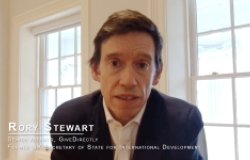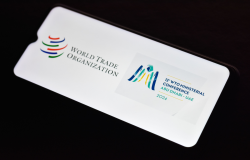Managing Freshwater Inflows to Estuaries
In the second in a series of meetings on fisheries, ECSP and USAID host a discussion of estuaries, the threats they face, and the actions that can be taken to restore them.
Overview
Estuaries form where freshwater from the land meets saltwater from the sea. These delicate ecosystems—created by the mixing of salt, soil, and water at certain temperatures and speeds—play a crucial role in maintaining healthy and productive fish populations. In coastal areas of the developing world, fish provide a substantial amount of dietary protein and a significant source of income. "Estuaries are literally the social safety net for hundreds of millions of people," said Richard Volk of the U.S. Agency for International Development (USAID). But as freshwater inflows are altered—whether in their quality, quantity, or timing—the biological, chemical, and physical characteristics of estuaries also change, destroying the safety net by threatening fish stocks and calling into question food security and economic sustainability.
In the second in a series of meetings on fisheries, on December 7, 2006, the Environmental Change and Security Program and USAID hosted a discussion of estuaries, the threats they face, and the actions that can be taken to restore them. Over the past two years USAID has partnered with The Nature Conservancy and the Coastal Resources Center of the University of Rhode Island to identify methods that developing countries could use to assess the relationship between altered freshwater inflows and the health of estuaries, and to integrate estuarine health into water resource allocation and management plans. Managing Freshwater Inflows to Estuaries: A Methods Guide is the result of that collaboration. "Our hope is that this guide will help us better understand freshwater inflows, as well as the what, when, how, and why of taking action," said Volk.
The Decline of Estuaries
Estuarine health around the word is heavily influenced by two factors: demographics and engineering. Over the past century, global population has tripled, while global water demand has increased more than six-fold, noted Volk. Technology has accompanied rising demand, allowing humans to harness freshwater resources, primarily through dams. "There is one new large dam commissioned either every day or every other day somewhere in the world," he commented. As dams capture and store water for human use, they fundamentally alter the flow of waterways, which has profound impacts on estuaries and their ecosystems.
The more water humans appropriate from river basins, the less is left for the survival of aquatic and marine organisms. Volk noted that artificially reduced flow produces a negative chain reaction that affects both ecosystems and human livelihoods: as inflows decline, less organic debris is swept downstream. Less organic debris, which provides nutrients for downstream ecosystems, means less plankton, on which fish and shellfish feed; and less plankton means fewer fish. And without fish, local fishers have less food security and fewer economic opportunities.
 According to Brian Richter, director of the sustainable waters program at The Nature Conservancy, this chain reaction is a particular concern on the Yangtze River estuary, due to the size of the population that depends on it. The water flow has been forever altered by the construction of the Three Gorges Dam, as well as other small dams within the basin. If, as a result of damming, biomass decreases and the ecosystems collapse, the result in the Yangtze basin could be devastating, he said: "Some of the really important food sources there are fish species [that] are the primary source of protein for tens of millions of human beings."
According to Brian Richter, director of the sustainable waters program at The Nature Conservancy, this chain reaction is a particular concern on the Yangtze River estuary, due to the size of the population that depends on it. The water flow has been forever altered by the construction of the Three Gorges Dam, as well as other small dams within the basin. If, as a result of damming, biomass decreases and the ecosystems collapse, the result in the Yangtze basin could be devastating, he said: "Some of the really important food sources there are fish species [that] are the primary source of protein for tens of millions of human beings."
Water quantity is not the only concern within estuaries. The timing—or "pulsing"—of the water through the system is also crucial. Water flow has a natural cycle throughout the season: less in the dry summer months, greater during the rainy season. Species have adapted to these natural flows, but if the flows are disturbed, species' life cycles are thrown out of sync, making them more vulnerable to predators. Richter pointed out that poor water quality is similar to a chronic condition like high cholesterol: if it isn't controlled, cholesterol can contribute to heart problems. Changing water quantity and timing, however, can have a much more dramatic impact: if a population of fish has a life span of four years, and the hydrologic pulse that enables them to reproduce is removed for five, the result is cardiac arrest. "Depriving the system of the right quantity and timing can be absolutely fatal," he said. "As we are developing and utilizing water resources, we need to be attendant to the need to preserve the natural pattern of rising and falling water levels, as well as the absolute volume of water."
Getting the Timing Right
 In some areas, water policies are being put in place to restore the quality, quantity, and timing of inflows. But in other places, change is a tough sell. The first step, according to University of Rhode Island's Stephen Olsen, is to persuade people with convincing stories. In Texas, for example, data links the rapid decline of a profitable shrimp fishery to the decline of the inflow to the estuary feeding the fishery, he said: "When they got cutoff from the freshwater, their fishery collapsed." Similarly, before construction of Egypt's Aswan High Dam, large quantities of nitrogen, phosphorus, and silica in the Nile River supported highly productive fisheries in the Mediterranean. But after the erection of the dam in 1965, the flow of the Nile was reduced by 90 percent; mullet, redfish, bass, herring, sardines, and anchovies were just a few of the fisheries to completely bottom out as inflow declined.
In some areas, water policies are being put in place to restore the quality, quantity, and timing of inflows. But in other places, change is a tough sell. The first step, according to University of Rhode Island's Stephen Olsen, is to persuade people with convincing stories. In Texas, for example, data links the rapid decline of a profitable shrimp fishery to the decline of the inflow to the estuary feeding the fishery, he said: "When they got cutoff from the freshwater, their fishery collapsed." Similarly, before construction of Egypt's Aswan High Dam, large quantities of nitrogen, phosphorus, and silica in the Nile River supported highly productive fisheries in the Mediterranean. But after the erection of the dam in 1965, the flow of the Nile was reduced by 90 percent; mullet, redfish, bass, herring, sardines, and anchovies were just a few of the fisheries to completely bottom out as inflow declined.
The methods guide attempts to help local communities understand the impact of inflows on estuaries, fisheries, and economies. Focusing less on large systems and more on small- and medium-sized estuaries, the guide is really a tool for poorer countries where "change is very fast, money is short, technical capabilities may not be there, and the abilities to deal with the governance of linking these systems is fragmented and weak," Olsen said. The guide addresses the poorly understood variables of volume and pulsing to change the conventional wisdom of water management, he said: "In many developing country contexts, especially where freshwater is scarce, people say—and you hear this in all languages—‘freshwater that runs to the sea, is freshwater wasted'."
The guide provides a five-point strategy for creating the enabling conditions for healthy estuaries:
- Identify issues and constituencies: build awareness through storytelling and conclusive data;
- Set goals, actions, and a strategy: embrace what works, discard what doesn't;
- Negotiate government commitment: outline clear goals, mandate, funding, and institutional structure;
- Adaptive implementation: disseminate findings and practice adaptive management; and,
- Evaluate and learn: hold frequent self assessments, external peer reviews, and set goals for future generations.
Estuaries around the world are impacted by altered inflows. The methods guide attempts to provide a way to navigate these waters, as the process is not all science: restoring inflows is as much a political process as it is a biological one. Policymakers, Volk pointed out, will act when citizens understand and care about an issue enough to demand change: "The question for us is whether and how the world citizenry and the resource managers can come to an agreement on what to care about before it is too late."
Drafted by Alison Williams.
Speakers
Hosted By

Environmental Change and Security Program
The Environmental Change and Security Program (ECSP) explores the connections between environmental change, health, and population dynamics and their links to conflict, human insecurity, and foreign policy. Read more
Thank you for your interest in this event. Please send any feedback or questions to our Events staff.









